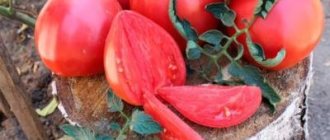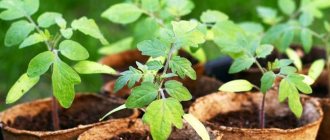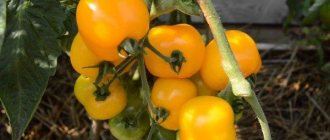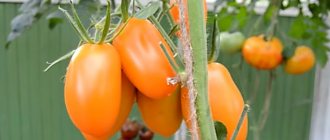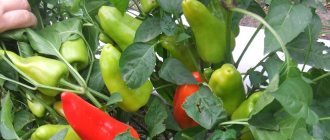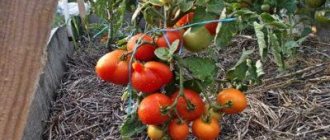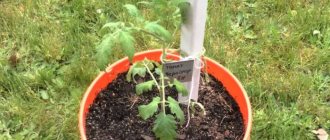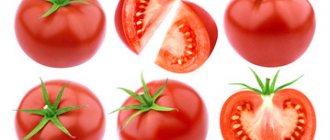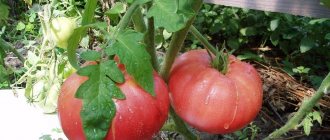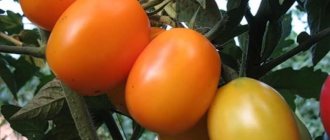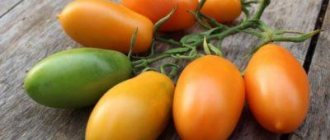Description
Belongs to early ripening varieties, ripens approximately 103-105 days after germination. The determinate type bush grows 40-50 centimeters in height. It is weakly branched, with large green leaves, and has a simple inflorescence.
The fruits are flat-round, dense, and not subject to cracking. Their weight can range from 100 to 140 grams; at the ripe stage, tomatoes turn red. They have an excellent sweet and sour taste and a characteristic aroma of tomatoes. They are distinguished by the friendly ripening of fruits, which is very popular with many summer residents. From one square meter you can get up to 7 kg of tomatoes. They are used fresh for food, in the form of salads, and do not lose their taste during processing. Suitable for making juice and sauces. The fruits can be pickled whole for the winter.
The June variety is included in the state register of the Russian Federation as suitable for cultivation in open soil and greenhouses. It can be planted throughout Russia and Ukraine, creating the necessary conditions for tomatoes, depending on climatic conditions.
General knowledge about the variety
All types of tomatoes can be divided into two according to growing conditions:
- in open soil;
- in closed ground.
The amphidiploid “Early Girl” was bred by breeders primarily for cultivation in greenhouses. Its main feature can be considered high protection against late blight. This is due to the fact that the vegetable ripens before the disease begins to spread. Thus, the only thing left to do is to reduce crop losses to a minimum.
And to ensure continuity of tomato harvesting over the course of that season, most gardeners, in addition to early-ripening varieties, plant different types of tomatoes.
Until this time, one difference of a tomato is the fairly active growth of the plant. Many bushes grow more than a meter in height and therefore need to be tied to a support.
Advantages and disadvantages
Tomatoes of the June variety have a number of advantages, thanks to which they are chosen for planting:
- excellent taste of the fruit;
- the culture is universal in application;
- ease of care;
- stability of high yields;
- resistance to a large number of diseases characteristic of nightshade crops.
Experts and gardeners who grow June variety tomatoes say that they have only advantages in the complete absence of any disadvantages.
Features of ultra-early varieties
The attitude of experienced gardeners towards early varieties is extremely positive. The reason is not only that it will be possible to taste the first fruits early enough.
Early varieties have other important features:
- Absence of such a problem as late blight. By the end of summer, when the development of the fungus reaches its highest stage, most of the crop has already been harvested.
- A wide variety of varieties, representatives of which can reach different heights, from 0.45 meters to 2 meters. With this choice, each gardener will choose the tomato variety that suits him.
- The fruits of early tomatoes have different taste qualities. Due to the fact that such varieties ripen in mid-summer, when the sun is most active and daylight hours are long. The tomatoes become sweet, their pulp has a delicate aroma. It is preferable to use tomatoes for making tomato juice. This will be confirmed by every housewife who planted an Early Girl.
- The fruits of early tomatoes are rarely very large. Their weight ranges from 0.05 kg to 0.2 kg. There are exceptions: some tomatoes can reach a size of 400 grams.
- The yield of early varieties is quite high. Depending on the variety, you can get up to 15 kg of tomatoes per square meter from one bush. Before planting tomatoes, you should determine your planting pattern.
Taking into account these specifics, you can select an early variety of tomatoes that is suitable both in terms of taste and in terms of the ripening period. All gardeners who sow the Early Girl tomato variety will be satisfied with its characteristics.
Preparing for sowing
Before planting, the seeds are first checked for germination by dipping them into a 5% saline solution. Seeds that are unsuitable for planting float, those that remain at the bottom are taken out and dried. To grow stronger seedlings, they need to be hardened off for 10 days; this is done as follows: put in the refrigerator at night, and kept warm during the day. On the day of sowing, the seed is soaked in “immunocytophyte” for 30 minutes, then placed in “Epin-extra” for 3 hours.
The soil is also prepared in advance; during the winter it is either taken out into the cold or brought into the warmth. Before planting, you can add a little wood ash to the soil.
Lists of other popular early tomatoes
The most productive
- F1 debut
- Katya F1
- Cupid F1
- Legionnaire F1
- F1 President
- Jaguar F1
Pink
- Bokele F1
- F1 doll
- Novosibirsk pink
- Pandarose F1
- Pink Spam F1
Yellow
- Buyan yellow
- Golden heart
- Early sunshine
- Tom yellow
- Cherry Kira F1
Black
- Ashdod F1
- Chocolate cream
- Forte Akko F1
- Cherry Negro F1
- Chocolate bunny
For the Middle Band
- Openwork F1
- Moskvich
- Moscow smear early ripening
- Diva F1
- Semko-Sinbad F1
- Talalikhin
For the Urals
- White grapes
- Red Guard F1
- Extra early
- Sprint-2
- Ural early
For Siberia
- Barnaul Cannery
- Broody
- Lazy
- Polbig F1
- Siberian early ripening
- Checkbox
Tolerant to late blight
- Baikal early (Baikal early ripening)
- Explosion
- Volgograd early ripening 323 (Volgograd early)
- Dubrava (Dubok)
- Mirishta F1
Growing seedlings
Prepared seeds are sown to a depth of 1 centimeter, then watered and covered, for example, with cellophane. For sprouting, the optimal temperature is 23-25 degrees. After the seedlings appear on the surface of the earth, the shelter is removed and the box with seedlings is placed in a bright place; a window sill is perfect; the temperature in the room can be reduced by several degrees. In the evening, young seedlings are illuminated, since daylight hours should be at least 15 hours.
After about two weeks, the seedlings will produce a couple of true leaves, which means that the plants can already be planted into separate containers. Before transplanting, seedlings undergo a hardening procedure; they are first taken out into fresh air for a few minutes, and the time spent outside is gradually increased.
Varieties of early varieties
According to the timing, early (early ripening) forms are distinguished with ripening in 90-99 days and ultra-early (ultra early ripening, super early, extra early) - 70-89 days. This division is very arbitrary, but there are grounds for it.
According to the type of stem, some tomatoes are standard - they have a thick, strong trunk. Low-growing standard forms can be cultivated without supports and garters.
- indeterminate (with unlimited upward striving),
- semi-determinant (they themselves stop growing at a height of 100-130 cm),
- determinate - low and bear 4-6 clusters on the main trunk;
- superdeterminate - very low and only 2-3 clusters on the main stem.
Schematic difference between determinate and indeterminate varieties of tomatoes
Transplantation into soil and care
The seedlings are planted in the beds; as soon as the weather returns to normal, the ground should warm up a little. Starting in the fall, the soil is fertilized with manure and compost, thus providing the bushes with nutrients for the entire season. In order to get an early harvest, plants are transplanted into the ground when the flowering phase begins.
The recommended planting pattern is 70 by 30, that is, no more than 6-7 plants should be placed on one square meter. As you know, bushes begin to bear fruit only after the root system has formed, so it is necessary to regularly hill up the bushes and loosen the rows so that enough oxygen reaches the roots.
Tomatoes need to be watered at least twice a week, preferably pouring water at the root, without getting on the leaves.
During the period of abundant flowering, you can treat the bushes with a stimulant, which helps the ovaries to form. The “June” variety does not require staking and removal of stepsons, but still, some gardeners advise forming a bush of 4 stems. You can fertilize with organic fertilizers, but there is no particular need for this; for this variety, the nutrients contained in the soil are sufficient.
Sowing tomato
Let's consider when to sow this variety. Each type of tomato is planted into seedlings at a certain time. If the correct timing for planting tomatoes is observed, the bushes will be healthy and produce a high yield. Tomato seedlings have a thick stem with 1-2 inflorescences. The distances between the nodes are small, 6-8 leaves grow on the stem. The time for sowing tomatoes depends on the climatic conditions of the area.
If the region has a cold climate, then the seeds of the Early Girl tomato variety should be sown in mid-March, and planted in a greenhouse no later than the first ten days of June. Seedlings can be planted in open ground only after the air temperature has returned to normal and there is no frost at night. You can determine the time when tomatoes are sown. If it is cool outside, the seedlings will need to be planted in open ground later. Therefore, the date of sowing seeds must be moved to the beginning of April. Flowers will appear 2 months after sprouting.
Description of the Shuntuk giant tomato, advantages of the variety and growing rules, reviews
The seeds that are selected for sowing must be of high quality. In order to choose good seeds, you need to do the following:
- You need to soak the seeds in a salt solution for 10 minutes.
- Those that float up are thrown away, the rest must be sown.
- They should be washed with water and sown in disinfected soil.
- To do this, the soil is preheated in the oven.
- After the seeds have been sown, the container is covered with film.
Sowing
One of the common mistakes of beginning gardeners is sowing early-ripening tomatoes too early. Their nature is such that the first flower raceme emerges very early, often after the 5th or 6th leaf. At the age of 45-50 days, the babies are already able to bloom. From flowering to ripening they take not 2 months (like mid-early and mid-ripening varieties), but 2-3 weeks less.
It is recommended to transplant plants into a greenhouse or outside before flowering, with buds on the first cluster. If you do this later, the flowers and ovaries may fly off due to stress. This way the first cluster will be lost - the fastest, most large-fruited and especially valuable for a low-growing bush.
So when to sow early varieties of tomatoes for seedlings? An approximate calculation is as follows: we count back a month and a half from the expected time of planting in the garden and another week for seed germination (it turns out 50-55 days). For the Middle Zone and Siberia, the approximate sowing time for early ripening plants for unheated greenhouses is from March 25 to April 1, for open ground - April 15.
Ultra-early tomatoes can be sown without seedlings - directly into the greenhouse (around the beginning of May).
In seedlings they do not stretch:
- Betta,
- Fighter (Buyan) red,
- Brawler yellow,
- Broody,
- Amber.
The best preparations from small tomatoes
There are many recipes for canning sweet small fruits:
- Red tomatoes are marinated using allspice peas, black pepper, bay leaves, and garlic cloves. These ingredients are placed at the bottom of liter jars. Preparation of the marinade is usually: for 750 milliliters of water - one and a half tablespoons of salt, two - sugar, take nine percent vinegar in the amount of four teaspoons. You need to pour the tomatoes twice: first with boiling water, then with boiling marinade.
- To improve the taste, add a bunch of tarragon, basil, parsley, and an umbrella of dill to the jars.
- Tomatoes are good in their own juice. To prepare the juice, take the same number of fruits as the Sweet Girl variety. Dill, pepper, bay leaf, and garlic cloves are placed at the bottom of the jars. Then the containers are filled with small fruits. Pour boiling water over them twice, draining the water. The third time comes the turn of boiled tomato juice, to which a tablespoon of salt and two of sugar are added per liter.
- For drying, whole tomatoes are placed on a baking sheet, placed in a ventilated, hot room. As soon as the fruits are dry, they are placed in jars and filled with vegetable oil.
Canned tomatoes, especially small ones, serve as an excellent decoration for the winter table.
Reviews
- Anna Vladimirovna, 27 years old:
Recently I have been growing only early varieties of tomatoes. I tried a large number of hybrids, but ultimately settled on the “Early Girl” variety. Particularly pleasing is the early ripening and excellent taste. - Kasatkin V.A., 40 years old:
Before I started planting the “Early Girl” tomato, I was tired of fighting late blight. The bushes were dying, they were sick, and I was losing up to half of the tomatoes that had set. Nothing helped. Now I'm calm. I'm not fighting the disease. I am harvesting before this infection appears.
Advantages of low-growing tomatoes
The “sweet girl” cherry tomato has many positive characteristics:
- The first harvest is harvested 95-100 days after emergence.
- The yield of the variety is about 0.6 kg per bush. To preserve the sweet taste, the fruits are removed when fully ripe.
- The height of the bush depends on the growing location. In flowerpots it can be no more than 50 cm, but in a greenhouse it reaches a meter.
Complex clusters form on the branches. Each of them contains up to eighteen small tomatoes. Some vegetable growers grow “sweet girl F1” tomatoes for decorative purposes: they are planted in flowerpots and placed on terraces along paths.
- High yield.
- Large fruits.
- Unusual tomato shape.
- Disease resistance.
- Suitable for transportation.
- To be stored.
The best varieties of tomatoes for open ground
Tomatoes 50-100 cm tall do not need to be tied up or the tie-down will be minimal;
Low tomatoes are most often early ripening. They ripen when late blight is not yet very active;
You don’t have to plant such tomatoes.
Every gardener wants ripe tomatoes to appear as quickly as possible without losing their distinct tomato flavor. Among the proven early ripening varieties is a tomato with the self-explanatory name Early Girl, a product of selection by Tver breeders. Vegetables have a long shelf life, are resistant to late blight, and have a juicy, sugary taste.
The low-growing Early Girl tomato is distinguished by a strong thick stem, a small distance between the nodes on the trunk, the presence of 6–8 leaves and 1–2 inflorescences.
The fruits are medium in size, there are almost no large ones. The weight of each reaches 50–200 g. Ripe tomatoes are bright red in color, rich in beneficial microelements, and have a mild sweet taste.
The harvest ripens 50–60 days after planting seedlings in open ground. An early girl gives a high yield: up to 15 kg of tomatoes ripen on 1 bush.
This variety, like any other, has its advantages and disadvantages.
Advantages of culture:
- fruits are stored for a long time and are easily transported over long distances;
- An early girl does not suffer from late blight due to the early ripening of the crop - the pathogenic fungus is most active only at the end of summer;
- The fruits have an excellent taste, aromatic pulp, and produce rich tomato juice.
The disadvantages of the variety are low resistance to low temperatures and the inability to self-pollinate.
How to grow
The variety loves soil rich in organic matter. Therefore, before planting seedlings or seeds, add organic compost to the soil. This will make it easier to care for the plants and allow them to develop well.
The ideal soil for the Early Girl variety is slightly acidic.
Sowing tomato
Before sowing, grains are selected to identify low-quality specimens. To do this, planting material is immersed in a saline solution for 10–15 minutes. Floated seeds are unsuitable for planting.
In regions with cool climates, tomatoes are grown in seedlings. Sowing seeds for seedlings is carried out in the first 2 weeks of March. Inflorescences appear approximately 2 months after the first shoots. The grown bushes are transplanted into a greenhouse or greenhouse before the end of May.
If seedlings are planted in open ground, they exclude the possibility of frost and be sure to use covering material. The seedlings are planted in a sunny place and covered with special material or film.
Attention! The timing of sowing depends on the planting location and climate in the region.
Pollination of tomato
The Early Girl variety does not pollinate on its own, so gardeners resort to artificial or natural methods.
Natural way of pollination:
- in windy weather, open the greenhouse to create a draft;
- Honey plants are planted between crop bushes to attract pollinating insects;
- flowers in pots are placed in the greenhouse - marigolds and basil have a good effect on the taste of future fruits;
- hives are installed (mainly in large greenhouses). This increases the yield by 30–35%.
Artificial method of pollination:
- with a brush - it is passed over the inflorescences, transferring pollen between them. They also use a toothbrush;
- shaking - each plant is held by the stem and gently shaken. This is how pollen is transferred and fertilizes the inflorescences. If the seedlings are tied up, then it is enough to lightly knock on the trellis;
- fan - the switched-on device is carried between the rows, directing the air flow to the plants, thus creating an artificial wind and pollinating the seedlings.
READ MORE: Planting viburnum and caring for it: pruning. How to replant and care for a summer cottage in open ground? How to grow ornamental viburnum?
Determining the time of pollination is not difficult - pay attention to the inflorescences. In the Early Girl variety, the pollinated flowers have petals curled back. If such a phenomenon is not observed, and natural methods of pollination do not help, artificial methods are used.
After the procedure, the bushes are sprayed with water from a hand sprayer or simply watered.
Attention! Pollination is carried out in the early morning to utilize fresh pollen that ripened at night. The procedure is carried out every other day while the bushes are blooming.
The Early Girl variety is not afraid of late blight, but is susceptible to diseases that appear at the initial stage of tomato growth.
The most dangerous diseases:
- tobacco mosaic;
- septoria, or white leaf spot;
- cladosporiosis, or brown spot;
- root rot.
To get a good harvest, crop diseases should not be allowed to develop. To do this, prepare the soil before planting and carry out preventive measures using effective and safe preparations.
The most popular and effective means:
- Potassium humate - 10 ml of the substance is diluted in 10-12 liters of water. Treatment is carried out when buds appear and at the first stages of flowering. The substance activates beneficial microorganisms in the soil, which increases crop productivity.
- Sodium humate - the substance from 1 sachet is poured into a prepared container, poured into 3 liters of hot water, and allowed to brew for 8-10 hours. The resulting mixture is diluted with water (1:10). Water the soil around the bushes with the prepared product. Sodium humate promotes plant development and reduces the risk of ovaries falling off.
- “Epin” - 1 ml of the substance is added to 5 liters of water, stirred. Spraying is carried out when buds appear and at the initial stage of flowering of the first cluster. The product is completely safe, since its main component, epibrassinolide, is a phytohormone found in plant cells. "Epin" increases the immunity of seedlings, increases the number of ovaries, thereby increasing productivity. The substance reduces the level of heavy metals and nitrates in tomatoes.
Do not forget about preventive measures against insect pests (aphids, cutworms, whiteflies, Colorado potato beetles).
For this purpose special preparations are used:
- “Phosbecid” - 10 ml diluted in 10–12 liters of water. Spray the plants in the morning or evening, 2 times per season, every 15–20 days. The drug is suitable for greenhouses and open ground;
- "Citcor" - 1.5 ml of substance per 10 liters of water. The solution is used immediately. Spray the bushes during the growing season, 2-3 times per season;
- "Iskra" - sold in tablets, powder, ampoules and bottles. 5 ml of the drug is diluted with 5 liters of soft water (preferably rainwater). If flakes appear in the liquid when the drug is infused, this solution is not suitable for processing.
Attention! To increase productivity and protect plants from diseases and insects, tomato bushes are sprayed with a solution of boric acid.
Reviews from gardeners
Vasilisa, Yaroslavl region: “For the last 3 years I have been growing only early varieties of tomatoes. I tried many varieties, but in the end I preferred the Early Girl. The fruits ripen quickly, bright red, as in the photo, and at the same time tasty and aromatic.”
Roman, Kostroma region: “A lot of effort and time was spent fighting late blight, which resulted in losses in the harvest. Two years ago, on the advice of friends, I decided to plant the Early Girl variety. Now I am completely calm about the harvest, since I collect it before the disease develops.”
Victoria, Tver region: “I heard a lot of good things about the Early Girl variety of tomatoes, so I decided to plant them myself. Indeed, the fruits ripen quickly, and with proper care the plants are not afraid of diseases.”
Conclusion
The Early Girl variety is relatively easy to care for, is not afraid of drought, and is not susceptible to late blight. However, the crop does not tolerate cold weather well and is not able to self-pollinate. With the right agricultural technology, closer to mid-summer it will be possible to get a rich harvest of fruits (up to 15 kg from 1 bush).
The pulp of tomatoes is juicy and sugary; they are used fresh, added to salads, and made into juices and sauces.
Features of pollination
The variety is not self-pollinating. Therefore, the main task of the gardener becomes the need to create conditions acceptable for growth and fruiting. There are two pollination options:
- Natural pollination.
It is necessary to attract bees, bumblebees, and other pollinators and ensure the movement of air masses. To do this, you will have to regularly open the transom doors in the greenhouse. Place honey plants between the rows. To improve the taste of the harvest, plant marigolds or basil. - Artificial pollination.
Pollinated tomato flowers curl their petals back. If this does not happen and the ovaries have not formed, it is necessary to carry out the procedure of artificial pollination. This should be done early in the morning, since the wind has not yet had time to blow away the pollen. Frequency – once every two days.
Artificial pollination methods:
- Using brushes to transfer pollen.
- Shaking the plant. The procedure must be carried out very carefully and with each plant.
- A fan can be used to ensure air movement in the greenhouse. Turn it on and walk between the bushes.
Having finished pollination, it is recommended to increase the air humidity. Watering or spraying will help with this.
Pollination of tomato
This variety is not classified as self-pollinating. Therefore, gardeners must pollinate plants. There are 2 methods: natural and artificial pollination. To create the opportunity for natural pollination, it is necessary to open the greenhouse during flowering, provide air movement there and attract bees for pollination. When it’s windy outside, you need to open the greenhouse. You can plant honey flowers between the rows to attract bees. Pollination with the help of bees increases crop yields by 40%.
Artificial pollination is carried out as follows. We need to inspect the flowers. A flower that has been pollinated has petals that curl back. If this is not the case, and the ovary does not form, then the tomatoes must be pollinated artificially. Pollination should be done early in the morning, since pollen ripened at night is not damaged by the wind.
What gardeners say about tomatoes
Those who grew the Sweet Girl hybrid leave only positive reviews about it. I like the simplicity of growing tomatoes. Many praise the variety for its high-quality and abundant fruiting. Sometimes it is not easy to collect tomatoes for harvesting, as they are quickly eaten by household members. Children are ready to feast on sweet clusters of red fruits all the time.
Using the fruits of the variety for canning, they note that much less sugar is used to prepare the marinade. The preparations turn out tasty and are eaten first. Sweet fruits are excellent for drying. They can be dried whole and used in winter for preparing main courses and salads.
Characteristics of tomato Early girl
At the stage of growing seedlings, a tomato can be distinguished from others by a strong, thickened stem, short internodes and the presence of 6-8 full leaves. Has 1-2 inflorescences. The fruits themselves are of medium size; large specimens are practically never found. A ripened vegetable weighs from 50 to 200 grams. It has a fragrant “tomato” smell and a mild, sweet taste. With a lot of useful substances. The color is bright red.
According to American agricultural technology experts, “Early Girl” is perfect for cultivation in conditions of lack of moisture in the soil. At the same time, the fruits become more fragrant. They make excellent tomato juice.
The disadvantage of this variety is its poor resistance to low temperatures.
tomato Paradise Apple - description and characteristics of the variety
Description of the variety
One of the varieties that has proven itself well is an early variety of tomatoes with the beautiful name Early Girl. The description says that this tomato is a hybrid one. Vegetable growers prefer this species because the fruits ripen quite early.
The number of tomatoes that grow on tomato bushes of this variety can be uncertain. The plant is quite tall, the bush needs to be tied up. The time that elapses from the time of planting seedlings to the appearance of the first fruits is small: from 50 to 60 days.
Early girl is a variety that does not tolerate low temperatures very well. If the threat of the first frost has not passed, replanting in the ground (especially in the open) should be postponed for some time.
The average size of a tomato is about the size of a tennis ball. The average weight of an Early Girl tomato is 130 – 140 grams. The color is very bright, the taste is pleasant, sweet. This characteristic is confirmed by reviews from gardeners.
Disease Prevention
Tomatoes are resistant to many known diseases, but require constant preventive measures. Planting land must be treated with copper sulfate or a weak solution of manganese. Young seedlings are sprayed with an antifungal drug (phytosporin) once every 14 days. Every 5 days the greenhouse is ventilated to prevent the appearance and spread of gray rot. Important! On contaminated soil, the cultivation of any nightshade crops should be suspended for 3 years.
Regular removal of the lower leaf blades and weeds will protect the seedlings from pests. Leaves affected by the disease are collected in a special container, taken out of the greenhouse and burned. Timely preventive measures taken will significantly help reduce not only the level of fungal diseases on the site, but also prevent the appearance of dangerous pests. The most important thing is to carry out all the necessary manipulations in time, before the fungus has spread too much.
WHERE TO BUY SEEDS OF LARGE-FRUITED TOMATOES
The scientific and production association “Gardens of Russia” has been introducing the latest achievements in the selection of vegetable, fruit, berry and ornamental crops into the widespread practice of amateur gardening for 30 years. The association uses the most modern technologies and has created a unique laboratory for microclonal propagation of plants. The main tasks of the NPO "Gardens of Russia" is to provide gardeners with high-quality planting material for popular varieties of various garden plants and new world selections. Delivery of planting material to the regions is carried out by Russian Post. We are waiting for you for shopping: NPO "Gardens of Russia".
Tomato Early girl characteristics and description of the variety, reviews and yield
How to grow Early Girl tomatoes?
Mystery
Varieties of cucumbers for open ground
This is an ultra-early ripening, compact, low bush 45-50cm high with a very powerful trunk. It takes 85-90 days from planting to ripening. The Riddle variety is very resistant to major diseases and has almost no stepsons. He is not afraid of low light. The weight of the fruit is 90-100 g, it is of universal use.
Example No. 1
Early ground tomato, according to the characteristics and description of the variety. Compact bush 40-50 cm high with weak branching. Ripening time is 85-105 days. The fruits are 50-100 g in size, slightly ribbed, have a very dense peel, which is ideal for preservation. But oak is also good fresh.
READ MORE: Strawberry Vikoda description of the variety, reviews from gardeners photos
Example No. 2
With the right agricultural technology and suitable climate, you can harvest up to eight kilograms of excellent tomatoes from the bush. Oak is grown in seedlings. Seeds are planted in mid-March. In the phase of two or three leaves they dive. Before planting in the ground, you need to feed the seedlings twice with complex fertilizers; they are planted at the end of May, after hardening them off within a week. Watering, like all tomatoes, once every 5-7 days, but you should not overdry the soil.
Kazabalyk tomato
This is an ultra-early, long-fruiting variety (from early June to October). Grown through seedlings. It should be planted in a permanent place when the threat of frost has passed. The land under Kazabalyksky needs to be thoroughly fertilized. Add humus, sand and ash to the hole. Its height is 50-60cm. The bush is all covered with tomatoes. Tomatoes weighing up to 50 g.
Example No. 3
The taste is average, but for such a long period of fruiting they can be forgiven. During the growing season, up to 800 fruits can form on the bush. He asks for a lot of water, at least a bucket under a bush. On very hot days, water twice a week.
Important! There is no need to stepchild him, although he will grow a lot of stepsons. They will all bear fruit.
There is no need to tie it up either. He will spread his branches on pre-prepared mulch and will “work”. This is such a wonderful high-yielding variety. Fruits with very thin skin. Used fresh and for processing.
Ultra Early Explosion is an improved version of the well-known White Naliv variety. Height up to 60 cm, fruiting occurs in 90-110 days. In the southern regions, Explosion seeds can be planted directly in open ground. In more northern areas, it is better to use the seedling planting method.
Example No. 4
Although it is not recommended to tie it up and pin it, it is still better to tie it up, since the branches may break due to the load of fruit. And it wouldn’t hurt to remove the extra shoots; the fruits will be larger. The only drawback of such a good tomato is that it is a hybrid and therefore there is no point in collecting seeds for subsequent planting. This variety is good for the Moscow region.
Red Fang
Determinate early ripening tomato variety. The bush is up to 80 cm high. It is simply hung with fruits, shaped like a fang and weighing up to 90 g. Individual tomatoes reach a length of 15 cm. It is grown, like all low-growing varieties, through seedlings and planted in a permanent place when the danger of frost has passed.
Example No. 5
Note! Vegetables of this variety withstand heat well and are able to maintain their proper appearance after processing.
Early girl
Tomato Early Girl is an early hybrid, a bush up to one meter high. It ripens 50-65 days after transplanting to a permanent place. The fruits have amazing taste, very sweet, without sourness, weighing from 50 to 200 g.
Example No. 6
Early Girl tomatoes are unusually productive: from one square meter you can get up to 15 kg of excellent fruit. This variety has very good immunity to various diseases. Plants do not tolerate low temperatures well, so it is still better to grow them in a polycarbonate greenhouse. But in warm areas it is possible in open ground. This variety is not self-pollinating. This means that bees or artificial pollination are definitely needed: shaking a bush or clicking a flower brush.
Sanka
Sanka is a determinant. Compact bush that does not require pinching. The fruits are medium in size and ideal in shape, as if calibrated. Each bush has several clusters. Tomatoes are dense, which is ideal for canning. Has time to ripen before being affected by late blight. Compared to the same early Lyana, it is not susceptible to blossom end rot. Sanka is a very cold-resistant variety. For areas of the Central Black Earth Region, especially those who do not have a greenhouse, this is an ideal option.
Example No. 7
Benefits of the sweet variety
The hybrid variety of sweet tomatoes is characterized by early ripening. After just 95 days in a greenhouse or under film, 100 days in open ground you can get a decent harvest of tasty small tomatoes. The main characteristics of the Sweet Girl fruits include:
- oblong-oval shape;
- thin, smooth skin;
- dense pulp with a high percentage of dry matter;
- sugar content;
- weight about twenty grams;
- excellent transportability;
- long-term storage.
To preserve the sweet taste of the fruits, they are picked when they are ripe enough when their color turns red. Up to half a kilogram of tomato is harvested from one bush.
Cherry tomatoes, which include Sweet Girl, are distinguished by many advantages:
- The dietary product is valuable because it contains many vitamins, antioxidants, and microelements that are beneficial to humans. And the amount of dry matter is twice as much as in large tomatoes.
- The fruits are used for dessert; children love to feast on them, like bunches of grapes. They taste better than other tomatoes.
- The fruits are consumed fresh to prepare original salads. Tomatoes go well with cheese and herbs.
- After harvesting, canned products are prepared by combining fruits of different colors.
The benefits of the Sweet Girl tomato are enormous. By eating red fruits, you can forget about cancer. They improve your mood and make your cardiovascular system work better.
Mid-season, medium-sized variety of large-fruited tomatoes. Recommended for growing in a greenhouse, in the southern regions - in open ground.
The height of the bush is 1.5 m and about 1 meter, respectively. Requires tying to the support and pinning. It is best to form 1-2 stems.
The fruits are barrel-shaped with asymmetrical ribbing, large, red in color at maturity, weighing up to 1 kg. If you want to get very large tomatoes, you need to normalize the number of ovaries in the bunch. The taste is good, tomato, without acid. The purpose of the variety is salad.
To achieve the full potential of this variety, fertilizing is necessary throughout the season.
In some catalogs this variety is called Magnificent Bonnie.
Reviews from those who planted Big Girl tomatoes are unanimous that they are worth growing, as they are tasty and productive, and also large in size. Some gardeners noted a drawback of the variety - there are voids in the fruit.
This is a natural variety of tomato. Therefore, we recommend taking seeds from a ripe fruit and growing them again next season!
Selection principles
First you need to decide on the landing site. The selection of varieties will depend on where you plan to grow tomatoes - in a greenhouse or outdoors (in a garden bed, in a greenhouse).
Greenhouse conditions
In closed ground it is beneficial to use all the useful height and long-term heat. Here we need tall bushes with a long fruiting period, resistant to diseases. Two groups meet these conditions:
- early ripening indeterminate and semi-determinate hybrids;
- long stem cherry trees.
Sometimes compactors—super-determinate varieties—are planted along the outer edge of greenhouse beds as a border.
Open ground
How to choose early varieties of tomatoes for open ground?
In cases where the owner has the opportunity to tie up the plants well and devote time to moderate pinching, it makes sense to grow semi-determinate varieties and hybrids - they are more productive.
Determinate and super-determinate plants require minimal attention. Some standard forms do not even need a garter. Sometimes they are planted up to the first cluster for the earliest possible ripening, but they can do without shaping. The lowest-growing tomatoes produce little return from the bush, so it is more profitable to place them more densely - up to 9 pieces per square meter.
Determinants themselves limit their growth and do not need pinching of the tops in August. They literally “run away” from infections, forming crops before late blight and other pathogens become rampant. Ultra-early ripening low-growing varieties quickly free up beds for replanting (greens, radishes, green manure, etc.).
Even in northern farming zones, the earliest varieties of tomatoes successfully bear fruit. They are the main focus in harsh regions with short summers.
For the sake of an early harvest, you have to put up with the fact that early-ripening tomatoes cannot be very large and fleshy. Many of them have thin skin and watery pulp; they burst when salted (pickled) in a hot way.
For whole-fruit canning, you need to select cherry or plum-shaped tomatoes - they are denser. Hybrids are also a good option - they are usually a bit harsh in salads, but good in pickling.
Best reviews from our readers
The tomatoes are large, orange-red, hollow, with virtually no juice. Such fruits are used for stuffing. But these are too big. Apparently, they are suitable for drying, making horseradish and ketchup.
The variety left a double impression: at first it was not very fun to knit, although it grew over 2 meters, then somehow gradually it inflated large fruits (from 300 to 400 grams), very beautiful in appearance, but with voids inside. Now, at the beginning of September, the bush is healthy, but the fruits come with sores: some veins, compactions and a generally unhealthy appearance. But she still knits from leftover navels.
Tomato Pink Girl F1 is a determinate medium-sized hybrid. Description of bushes:
- shoot height 1.2 m;
- powerful stems;
- 5-6 tomatoes per bunch.
Medium ripening - 110-123 days from germination.
- average weight 230-280 g;
- bright crimson color;
- the skin is strong;
- ribbing is weakly expressed;
- the pulp is fleshy, sugary;
- seed chambers 4;
- dry matter level 5%.
The taste has a harmonious combination of sweetness and sourness.
Tomato Sweet Girl F1 is a determinate medium-sized hybrid. Cherry bushes are compact and have moderate branching. Shoots do not grow higher than 1 m. The foliage is weak. 10-15 tomatoes are formed on the bunches. Ripens quickly in beautiful, abundant clusters. The harvest is harvested with brushes.
Ripening dates are early: in greenhouses after 90 days, in open beds after 100 days after germination.
- average weight 18-20 g;
- the pulp is moderately dense, sugary;
- the skin is glossy, durable;
- the taste is sweetish with sourness;
- color bright red;
- elongated oval shape.
Features of greenhouse cultivation
To obtain large yields, it is recommended to grow the variety in greenhouses. The “sweet girl” tomato independently regulates its growth. Its fruit raceme is formed above the sixth leaf. To get a big harvest, you need to properly prepare the soil. Only in this way will the seedlings quickly take root and be able to produce large yields.
When planting seedlings, several granules of mineral fertilizer are placed in each hole. Further care consists of moderate watering, timely fertilizing, ventilation of the greenhouse and loosening the soil.
Early varieties of tomatoes for greenhouses
To grow seedlings on time, seeds are sown at the end of February and throughout the first half of March.
How to plant and grow:
- embedding depth 2 cm, distance between grooves 5 cm;
- temperature regime 22 degrees;
- irrigation from a spray bottle with warm water;
- diving with 2-3 true leaves;
- hardening 10 days before transplantation.
For better growth, seedlings are fed 2 times with Kemira-universal.
User rating: 5/5
User rating: 5/5
golden brush
Early ripening indeterminate variety (95-98 days) for protected soil. A plant up to 150 cm high needs staking and pinching. The fruits are small (20-30 g), pear-shaped, golden yellow, dense, with excellent sweet taste; form beautiful large brushes. The purpose of the variety is universal.
